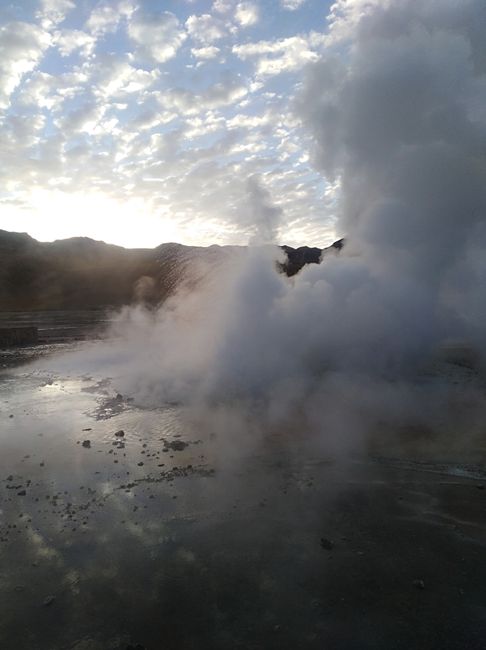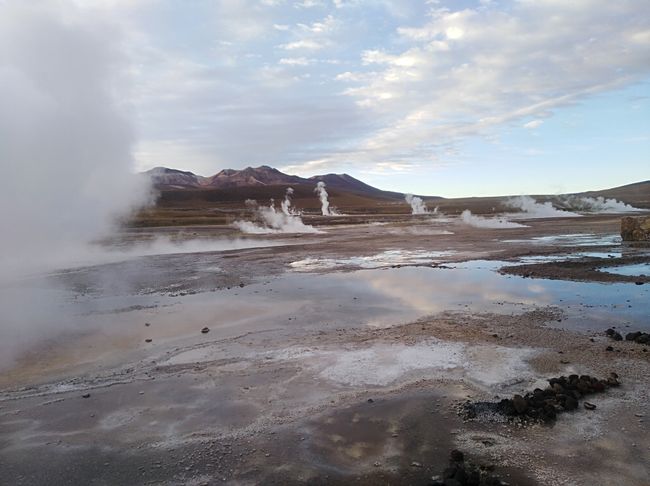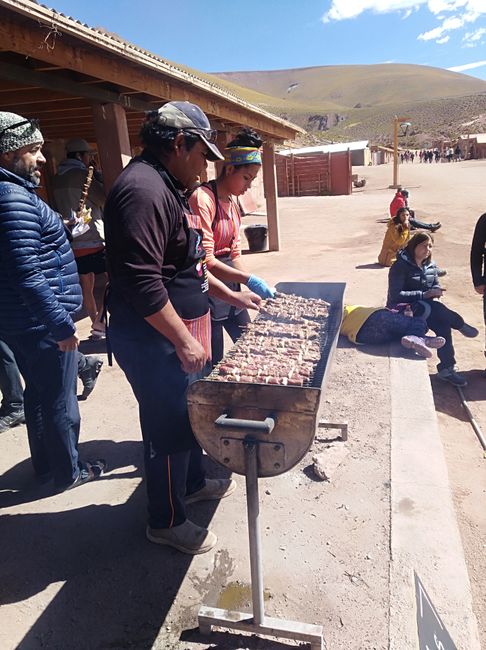Lagoons, salt lakes, geysers, and vicunas - that's what we imagine a desert to be like?!
Ipapashiwe: 17.01.2020














Bhalisela kwincwadana
After a short night (4 rings from the phone), we bundle up because we are going to 4800m, where we want to see the "Geysers del Tatio". They are most active at dawn, when the surface water thaws and the fumes are most visible, due to the high temperature differences. The water vapor has a temperature of 80 °C, perfect for making mate tea. However, we are advised against it because the geysers are marked with stone circles. Three people have already died from burns.
It's damn cold and an icy and unusual wind is blowing. But the natural spectacle is impressive. Surrounded by mountains, you stand in a valley and the whole meadow is smoking like crazy. At the same time, the sun slowly rises behind the mountain peaks.

We are given an explanation of the different types of geysers and learn that these are the highest and largest in the world. However, they are not typical because they have no contact with the magma chamber of the active volcano. There is a layer of earth between the magma chamber and the water, and this heats the water. As a result, it expands and the temperature differences build up pressure that propels the water upwards. We can observe fountains up to 7m high. Help, I'm standing on an active volcanic area.

But the coolest thing about the trip for me was being able to "see" extremophile archaea for the first time. These are very old microorganisms that can survive in very cold and hot temperatures, as well as high salt concentrations. You can recognize them by their pink color, which allows them to generate energy like plants from light. (ok, I'm done with the biofreak mode)


When the spectacle subsides, we are served a baguette avocado breakfast (in general, the food on the tours was super tasty) and then we are allowed to bathe in the hot springs. These are between 30 and 45 degrees Celsius, depending on the activity of the volcano.

Next, we go to Pueblo Macchuca, where we try lamb skewers. Finally, we are shown the Viagra plant and explained how to differentiate between the sexes of cacti.


After a lunch break, we visit Laguna Cejar, a salt lake that contains five times more salt than the Pacific Ocean. I am impressed, you can't swim here at all! As soon as you stretch your leg, it snaps back up! It is quite difficult to move around, so I try to paddle with my hands to reach the other side. A very strange feeling. At the end of the tour, we have a Pisco Sour during sunset.


After a short nap, we are picked up the next day at 6 am. Today we will visit the Altiplano Lagoons and Piedras Rojas. "Altiplano" is the region that lies above 3800m and stretches across the three countries of Peru, Chile, and Bolivia. Many indigenous peoples used to live here, who had to submit to Catholicism after the Spanish conquest. Accordingly, the masses here are said to be a similar mixture of religions as on Easter Island. Here, too, you can observe terrace farming from ancient China.
On the way to the lagoon, we can observe many vicunas and guanacos, which are the two wild species of llamas.

Vizcachas also show themselves. These are hare-like animals with a squirrel's tail, meerkat paws, and beaver teeth. A very strange mixture, but according to our driver, they are very delicious.
The lagoons at these altitudes are beautiful, so we take short hikes.


Afterwards, we go to the Mirador Piedras Rojas, where we can see more colorful salt flats. It sounds so simple now, but that was also a wonderful sight that I really enjoyed.

Finally, we visit Laguna Chaxa, one of the flamingo reserves in the desert. Normally, they are very shy, but they have gotten used to the presence of humans here. However, my highlight were little mini ducks that spin around in circles to search for food on the ground.

Overall, I would never have classified the places I was able to visit as a desert, but they are part of it. The internet provides various definitions of deserts, but the most likely assumption here is that evaporation must be greater than precipitation. In conclusion, there is life in the Atacama Desert in the form of many adaptable plants and animals.
Frieda (Jan 17)
Bhalisela kwincwadana
Phendula

Iingxelo zohambo Tshile

